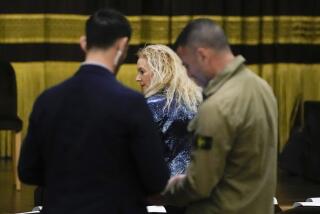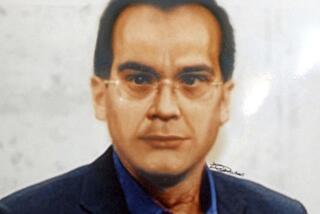Two nations, 33 spies and one Egyptian extremist
- Share via
MILAN, ITALY — The two spies were allies and kindred spirits.
Robert Seldon Lady, the CIA station chief in Milan, and Col. Stefano D’Ambrosio, the local head of the SISMI, Italy’s intelligence agency, shared pride in their fight against terrorism and disdain for self-serving bosses.
On a fall day in 2002, the American made an explosive revelation. He told D’Ambrosio that, over his objections, a CIA team was in Milan doing reconnaissance for the “rendition” of an Egyptian extremist ideologue. The American was worried that the risky operation would ruin his carefully built alliances, D’Ambrosio testified years later, and could even lead to a shootout between the Americans and the Italians if things went awry on the street.
With an urgent look, spy to spy, Lady said: “Talk to your people.”
D’Ambrosio recalled that he got the unspoken message: “In other words, he says . . . ‘This whole thing is so crazy that if . . . two operational chiefs in the field, who know the area, who work in this territory, say that an action is completely crazy, probably they will back off.’ ”
Four months after the conversation in Milan, the CIA allegedly abducted the cleric and flew him to Egypt, where he was tortured for months. An international scandal ensued: The accused abductors left a sloppy trail of phone activity, credit card charges and photo IDs that allowed Milan authorities to prosecute 26 Americans (in absentia), including the now-retired Lady, and seven Italian officials.
The brazen nature of the alleged rendition has gotten much attention. But the trial has also revealed how the Bush administration’s drastic tactics shook up the secret world of U.S. intelligence work overseas. Testimony has featured remarkable allegations about feuds and rogue conduct. The case apparently made and crushed careers and spread betrayal and suspicion among U.S. and Italian anti-terrorism officials.
On the witness stand in October, D’Ambrosio summed it up: “We were between the tragic and the ridiculous.”
The case arose from an extrajudicial practice known as “extraordinary rendition,” in which U.S. intelligence officials have secretly abducted terrorism suspects and transported them to secret detention facilities or to countries that subject the suspects to harsh interrogation and, sometimes, torture.
Unless otherwise noted, the following account is based on testimony during the trial, which has slogged on almost two years.
Tragic figure
Lady seems a rather tragic figure at the heart of the case: a veteran spy who, after the Sept. 11 attacks, established himself as a point man in the shadows of the battle against the Islamic extremist underworld. Although he took risks to try to stop the abduction, in the end he allegedly became one of its dutiful architects.
The bearded, curly-haired Lady, now 55, spoke excellent Italian. He thrived in the convivial culture of Italian law enforcement, doing business over espresso and long lunches, hosting barbecues. He cultivated bonds with anti-terrorism units of agencies that are wary of one another: the SISMI spy service, the paramilitary Carabinieri and the national police. He passed along valuable leads from U.S. intercepts and offered cash and high-tech equipment for costly stakeouts.
“We all had excellent relationships with him because this was a very affable and professionally accessible person,” testified Luciano Pironi, a Carabinieri lieutenant who confessed to a hands-on role in the abduction. “I think he had given CIA souvenirs to half of Milan.”
Lady also developed his own agents at a mosque that was a European hub for Al Qaeda, targeting a network suspected of sending militants to training camps in northern Iraq. He helped Milan anti-terrorism police build a case against the rendition target, Abu Omar, regarded as a vehement ideologue in the group.
At a discreet sit-down with D’Ambrosio in October 2002, however, Lady said that his CIA bosses had decided to circumvent the police and abduct Abu Omar, supposedly hoping to force him to become an informant. As a result, Lady was embroiled in a feud in his own agency. The American told D’Ambrosio that he had an “awful” relationship with the CIA’s Rome station chief, who resented Lady’s criticisms of the planned rendition and had sent a tough deputy to Milan to make sure he followed orders.
D’Ambrosio was dumbfounded. When Lady told him that the SISMI had dispatched Italian agents to help a team from the CIA’s paramilitary “special operations group” stalk the Egyptian, D’Ambrosio realized that his own bosses were keeping him in the dark about the plan.
Warning issued
Lady said he warned higher-ups that the idea was a colossal mistake.
He said “it would eliminate from the area a subject who was known to counter-terrorism forces,” D’Ambrosio said. “We knew what [Abu Omar] did, who he met, where he met them. . . . It would cause grave harm, because at the moment Abu Omar was substituted in his post, we would have to start all over again, with the risk that terrorist projects perhaps in the initial stage could be executed. . . . The subject they wanted to abduct was not certainly a subject who posed an imminent danger. Abu Omar did not go around with an AK-47 ready to shoot children.”
CIA bosses dismissed objections and got clearance from top officials in Washington. D’Ambrosio testified: “I’ll tell you my impression. . . . The only motive was career advancement. That is, to show Washington that [the Rome station chief] was a tough enough and skilled enough person to pull it off.”
D’Ambrosio said he hurried to Bologna to urge his boss, Marco Mancini, to abort “an action in my territory . . . [that] was not only wrong but extremely dangerous. I expressed complete dissent.”
Mancini seemed surprised only that the American had confided in D’Ambrosio. A few weeks later, Mancini ordered D’Ambrosio’s transfer to Rome. Commiserating in Milan, Lady told his friend that the CIA chief in Rome had demanded D’Ambrosio’s head. And Lady made a startling disclosure about Mancini, who soon became the No. 2 chief of the Italian spy agency.
“He told me that Mancini had offered himself to the CIA as a double agent,” D’Ambrosio recalled. “And he said the CIA had made a negative response to the offer. . . . An analysis done by CIA psychologists based on conversations with Mancini had revealed according to them that Mancini had an extremely venal character.”
Mancini and other Italian officials deny that allegation. In addition to the Abu Omar case, Mancini has been charged with criminal conspiracy in a corruption scandal involving illegal wiretaps and an Italian telephone company.
Despite Lady’s initial objections, he is accused of setting up the abduction on Feb. 17, 2003. He allegedly recruited Pironi, the Carabinieri lieutenant, who confessed to using his badge to stop Abu Omar before masked men dragged him into a van. Pironi testified that Lady rewarded him with a paid six-day trip to the United States featuring a visit to CIA headquarters, where two top officials for European operations thanked him.
Meanwhile, the CIA’s former Rome station chief -- a defendant in the Milan trial -- was promoted after the rendition, Italian investigators said.
American and Italian spymasters have been accused of efforts at a cover-up. Two weeks after the disappearance, the CIA allegedly sent Italian agencies a false report indicating that Abu Omar had gone to the Balkans.
It took a year until Abu Omar was freed from prison in Egypt and resurfaced. The official story began to unravel. But Lady’s hard-won alliances and friendships with Italian police had already fallen apart amid suspicion and silence.
The U.S. government has refused to comment. The Italian government has tried to scuttle the prosecution in the name of state secrecy laws. Responding to a high court decision on a government appeal, the judge here will decide Wednesday whether the trial can continue and what evidence can be used.
--
Rotella was recently on assignment in Milan.
More to Read
Sign up for Essential California
The most important California stories and recommendations in your inbox every morning.
You may occasionally receive promotional content from the Los Angeles Times.













